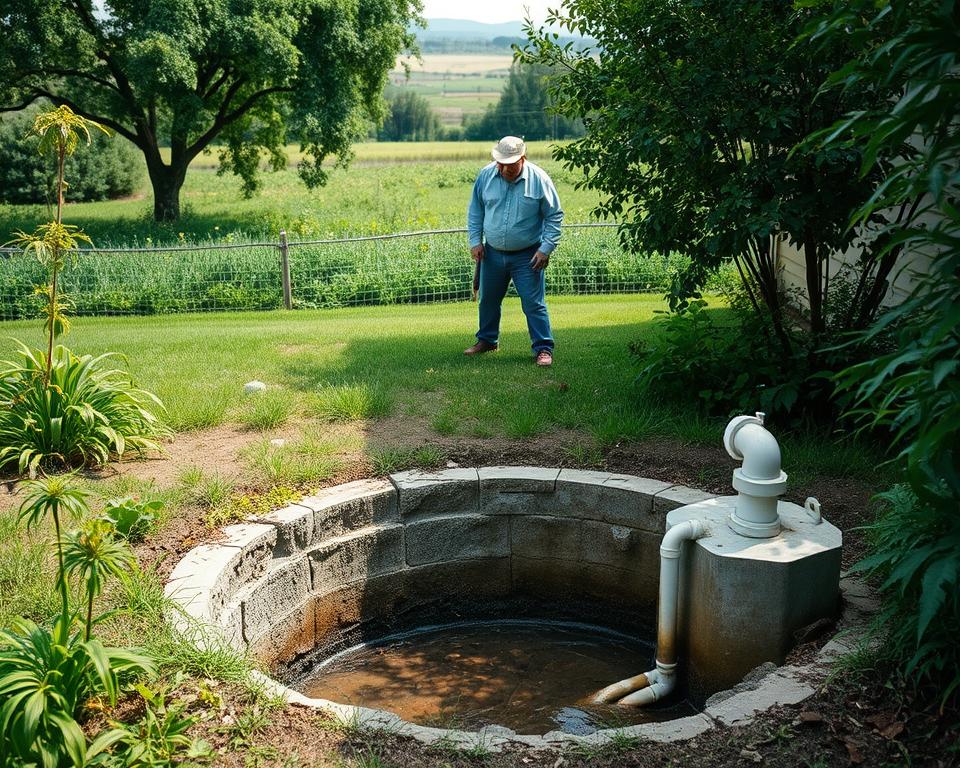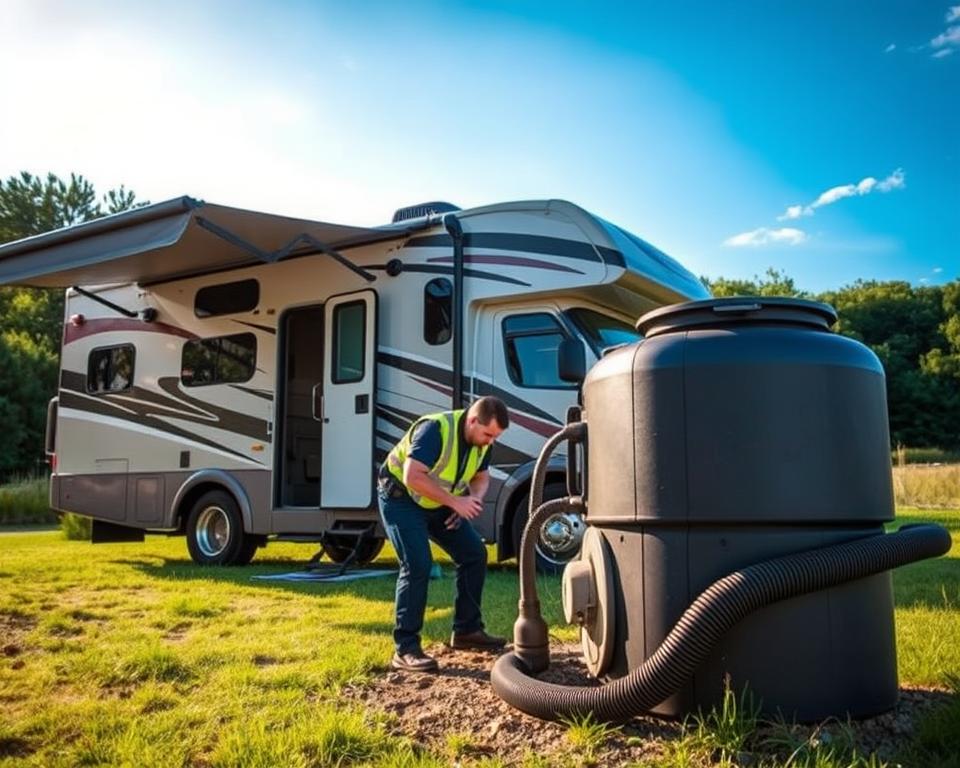RV Sewage Tank Pumping: Key Upkeep Guidelines
Consider the consequences of neglecting your RV’s septic system. Many RV owners find the idea of septic tank pumping daunting. However, recognizing the need for regular servicing is crucial. These steps preserve your camping joy and avoid expensive repairs. Learning proper waste disposal is key to your septic health. Here are key pointers on mobile RV tank pumping with upkeep advice to ensure your system operates flawlessly.
Understanding Your RV Septic System
Your RV includes tanks designed for different wastes. It consists of a black tank for toilet use, a gray tank for sinks/showers, plus a freshwater reservoir. Grasping how each part works is key to proper black tank servicing and overall system care.
A series of drain lines and vent pipes balance waste flow and airflow. Understanding this synergy helps you avoid blockages and buildup. This knowledge ensures hassle-free trips and reliable waste handling.
Maintaining clear, working tanks requires routine effort. Frequently checking tank levels and emptying on time preserves comfort. Proper upkeep extends tank life and enhances every journey.
The Value of Consistent Septic Maintenance
Routine sewage draining preserves functionality and hygiene. Leftover solids lead to smells and clogs, spoiling your trip. A full tank can produce embarrassing backups. Such mishaps kill the fun on the road.
Neglecting tank emptying invites expensive fixes. Damage from neglect can shorten component lifespan. Regular pumping ensures seamless operation. You’ll avoid nasty surprises and costly breakdowns.
Staying on top of maintenance wards off backups. Dedicating effort to pumping reflects good RV stewardship. Your trips become more relaxing. By sticking to a dump schedule, you’ll relish the outdoors worry-free.
Finding the Right Dump Frequency
Determining dump intervals needs careful thought. Common guidance suggests a 3–5-day window. However, it shifts based on tank volume and number of users. Pinpointing the correct dump time is key for effective wastewater management.
Dump the black tank at about two-thirds capacity. It ensures good drainage and cuts down on odors. Ignoring it can cause backups and unpleasant odors.
Many elements can affect how often you pump:
- Number of people on board
- Length of stay
- Type of waste generated
- Tank capacity
Scheduling prevents on-the-road crises. Remember portable toilet service schedules. Knowing your patterns predicts when to dump.
| Usage Scenario | Pumping Frequency |
|---|---|
| Short Trip, Two Campers | Every 3–4 days |
| Extended Trip (4–6 people) | Every 2–3 days |
| Seasonal Living (2–4 people) | Weekly or Bi-Weekly |
Monitor fill levels and usage patterns. This proactive stance ensures enjoyable travel.

Top Methods for Emptying Your Tanks
Correct dumping preserves system health and prevents issues. Begin with the black tank to avoid cross-contamination. It keeps gray water from mixing with solids.
A sturdy sewer hose reduces spill chances and aids flow. Tighten connections to stop spills. After emptying, flush the black tank with plenty of water. It clears lingering waste for a cleaner tank.
Know where dump stations are located. Being prepared saves time on the road.
To summarize, use these steps:
- Empty the black water tank first.
- Use a top-quality sewer hose.
- Flush the black tank thoroughly after emptying.
- Plan your dump station locations.
These tips refine your waste disposal process.
Tank Handling and Upkeep Best Practices
Grasping correct handling of black and gray tanks ensures system health. Keep some water in the black tank for better breakdown.
Refrain from disposing non-biodegradable items. Use only RV-compatible paper. Regular checks spot leaks or cracks before they worsen.
Occasional treatments boost system performance. They introduce microbes that digest solids effectively. Simple steps ensure smooth tank operation.
- Check for leaks and damage often.
- Apply RV-specific chemical treatments.
- Keep vents clear to avoid odors.
Following these rules protects your septic setup. You’ll enjoy more worry-free trips.
RV Septic Tank Pumping: Key Tips for Success
Successful pumping requires precision and a clear procedure. Proper disposal prevents issues—only dump at approved stations. Know your tank’s capacity to avoid overflows.
Monitoring levels guides your dump schedule. Routine scheduling preserves your septic system and travel enjoyment. A planned maintenance routine keeps everything running smoothly.
Rinse tanks thoroughly post-dump. It ensures each dump is cleaner than the last. By applying these strategies, you’ll maintain your RV’s condition and comfort.
Typical RV Septic Pitfalls
Maintaining your system is vital for uninterrupted camping. Insufficient flushing causes solids to accumulate. Proper flushing dissolves waste better.
Wrong flushables cause havoc—never flush wipes or towels. Only biodegradable RV-safe items belong in the black tank. They cause backups and costly service calls.
Leaving the black valve open too early is a mistake. Open valves let water out but hold solids, causing residue. Only open when ready to empty for a complete clean.
Awareness of these errors boosts system longevity. Avoiding them keeps your waste management reliable.
When to Call in Professional RV Waste Disposal Services
Knowing when to hire pros preserves system health. Lingering smells can mean serious tank problems. Tanks that empty sluggishly hint at internal blockages.
Visible residue at dump points requires attention. It often calls for a deep professional clean. Experts use specialized tools to clear stubborn clogs.
Regular expert check-ups safeguard tank health. Acting on findings quickly prevents bigger problems. Professional service ensures proper functionality.
Sustainable Waste Management Strategies
Smart upkeep ensures lasting system performance. Scheduled dumps preserve longevity and operation. Routine rinses clear residue and stave off expensive breakdowns.
Implementing clean cycles safeguards tank health. Checking seals and joints avoids leaks. Opting for biodegradable products protects plumbing.
Keep these habits in mind:
- Stick to a pump-out timetable.
- Rinse often to remove solids.
- Sanitize twice a year.
- Inspect parts frequently for wear and tear.
Investing in prevention brings peace of mind. Through consistent upkeep, you’ll enjoy travel free from waste worries.
Bringing It All Together
Effective RV septic maintenance is crucial for a pleasant experience. Knowing system function and cleaning steps stops issues. Routine black tank dumping boosts performance. This makes your journey more comfortable.
By regularly checking and properly caring for your septic setup, you’ll ensure worry-free travel. This reliability supports every outing. These routines prime your rig for future rides. So you can focus on making memories, not dealing with tanks.


